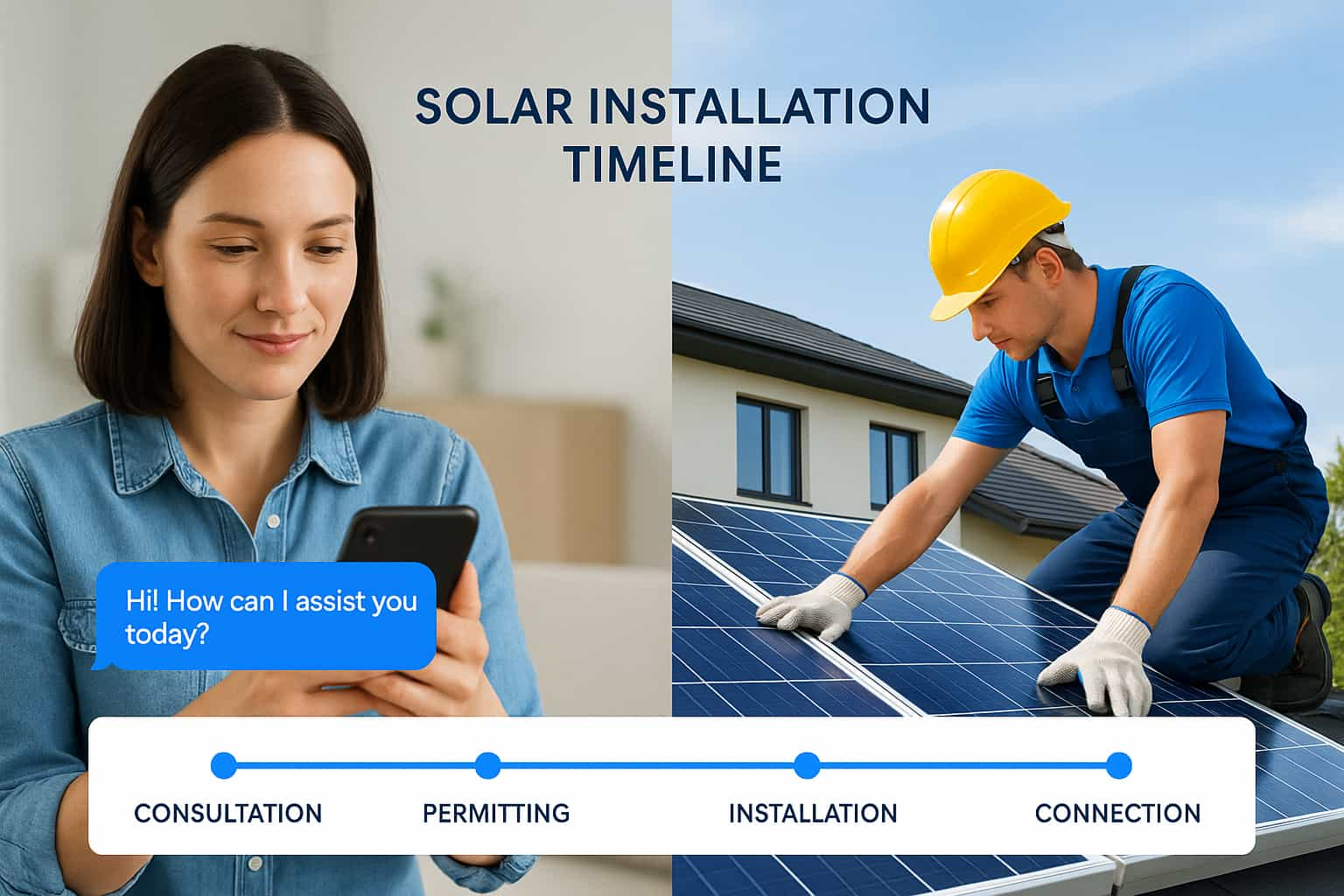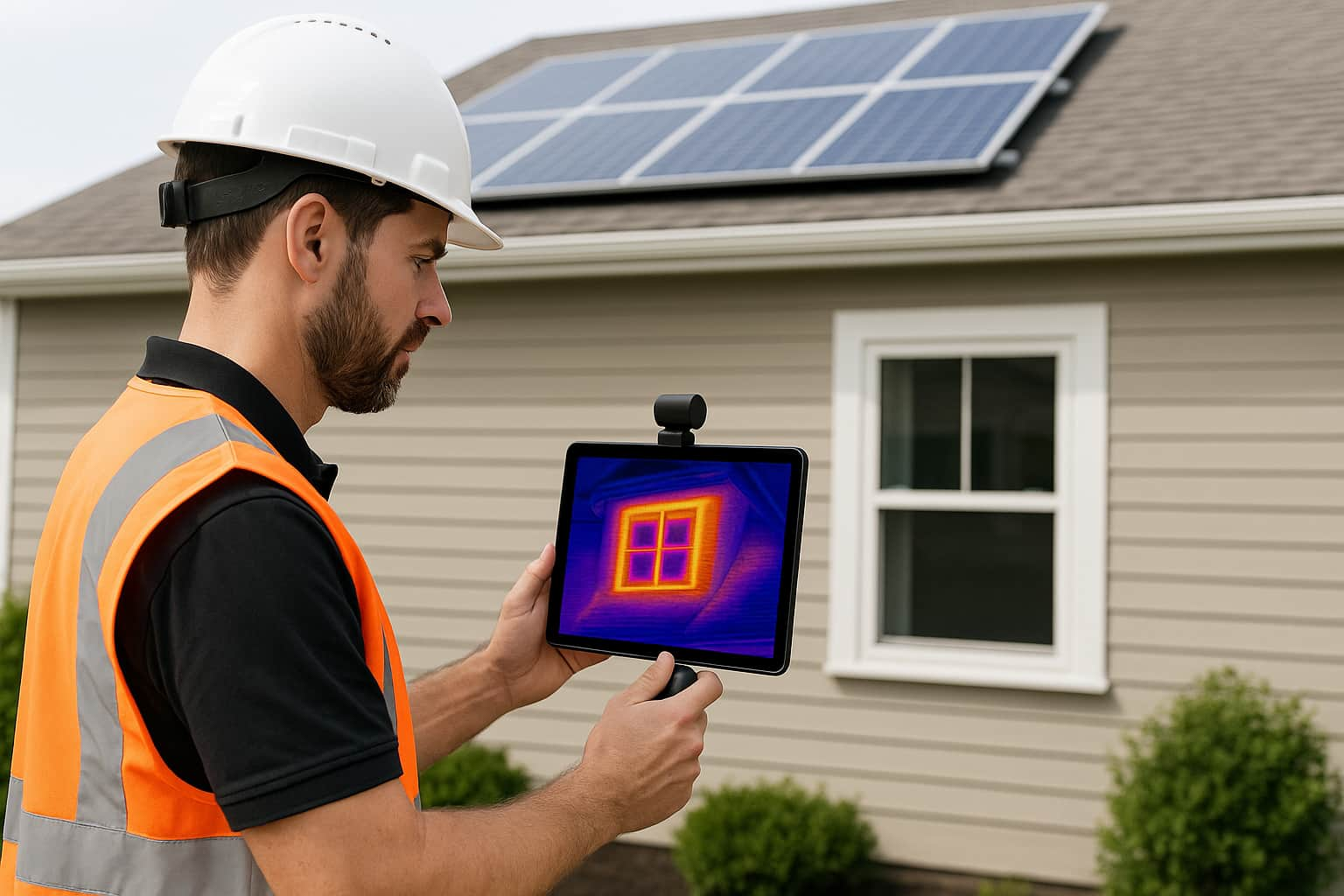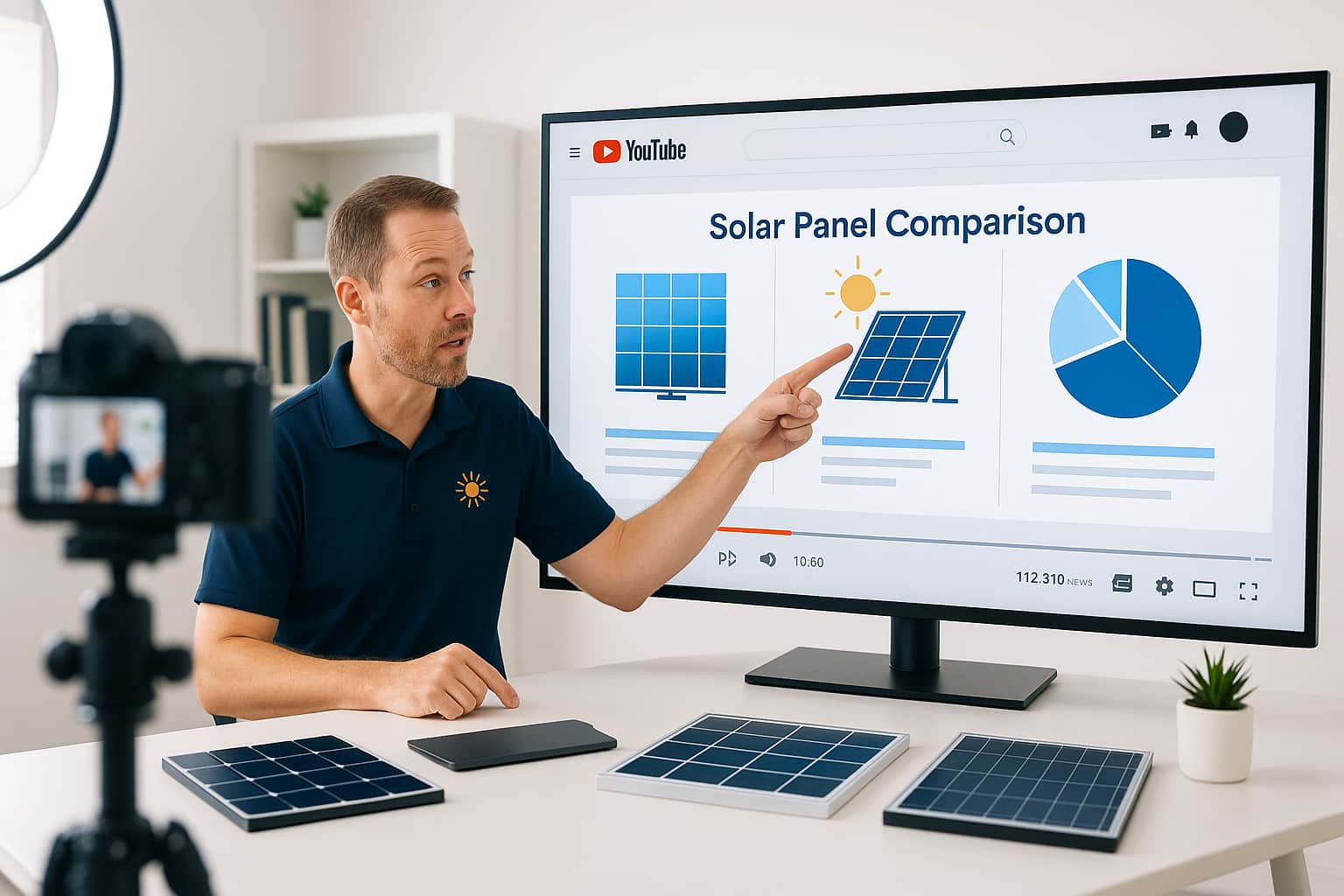How to Convert Solar Leads with a Chatbot That Builds Trust
Here's the truth about solar sales: customers hate not knowing how long their project will take. This confusion kills deals and wastes your digital marketing money.
Your potential customers want solar panels. But they worry about waiting months without clear answers. This fear stops them from signing contracts. It also makes your pay per call solar leads less valuable.
This blog shows you how a Solar Installation Timeline Chatbot fixes this problem. You'll learn how to turn timeline transparency into more qualified solar leads and better conversion rates for your services business.
Table of Contents
Why Solar Timeline Confusion Kills Solar Lead Generation
How Timeline Chatbots Build Customer Trust
Best Features for High Quality Solar Timeline Estimation
Converting Timeline Transparency into Quality Solar Leads
Smart Implementation for Growing Your Business
Measuring Your Solar Lead Generation Success
Why Solar Timeline Confusion Kills Solar Lead Generation
The "Solar Coaster" Problem
Solar installers call the installation process a "solar coaster" because timelines change so much. A typical home solar project takes 2 to 6 months. Most installers say 60 to 90 days, but that's only if everything goes perfectly.
Here's what actually happens during installation:
Initial consultation and design: 2-8 weeks
Getting permits: 2-7 weeks (sometimes 2+ months)
Ordering equipment: 1-4 weeks
Actual installation: 1-3 days
Inspections and grid connection: 3-8 weeks
The real installation only takes a few days. Everything else is paperwork and waiting.
Why Timelines Vary So Much
Permitting nightmares: The U.S. has about 20,000 different permit offices. Each one has different rules and speeds. This fragmentation is a fundamental driver of timeline variability.
Utility connection delays: Getting connected to the power grid involves lots of steps. A comprehensive NREL analysis shows this takes an average of 52 days, but 44% of projects wait 20+ business days just for the initial review.
Other delays include:
Installer scheduling backlogs
Equipment supply problems
Customer delays in reviewing paperwork
Bad weather stopping installation
The Cost of Timeline Confusion
Timeline uncertainty crushes solar businesses and wastes marketing efforts:
High cancellation rates: Approximately one-third of residential solar contracts in the U.S. are canceled. Most cancellations happen before permits are even submitted.
Wasted marketing money: Every canceled contract wastes money spent on sales, design, and project setup. This increases costs by 25% for installers.
Damaged reputation: Customers leave bad reviews when timeline expectations aren't managed well. This can have a lasting detrimental effect on a company's credibility.
How Timeline Chatbots Build Customer Trust
What a Solar Installation Timeline Chatbot Does
A Solar Installation Timeline Chatbot gives customers personalized project timeline estimates in real time. It uses real local data to provide accurate answers about how long their specific project will take.
The chatbot asks customers about:
Their property address
Type of solar installation they want
Approximate system size
Whether they want battery storage
Then it checks local permit office data and utility information to give a custom timeline estimate. This approach helps with how to get solar leads by addressing customer concerns upfront.
Why This Builds Trust
Immediate answers: Customers get timeline estimates right away, not after a sales call.
Realistic expectations: Data-driven estimates help customers understand what to expect.
Transparency from day one: Being honest about timelines builds trust from the first interaction.
No sales pressure: Customers can explore timelines without talking to a salesperson first. This is the best way to get solar leads because it builds trust naturally.
Key Benefits for Solar Businesses
Better lead quality: Customers who use the chatbot understand timelines before they contact you. This means better conversations with your sales team and higher conversion from solar lead generation efforts.
Fewer cancellations: When customers know what to expect, they're less likely to cancel due to timeline surprises.
Competitive advantage: Most solar lead generation companies don't offer timeline transparency. This makes you stand out in search results and on social media.
More efficient sales calls: Your team spends less time explaining basic timeline questions and more time closing deals. This is especially valuable for commercial solar leads that require more complex timelines.
Best Features for High Quality Solar Timeline Estimation
Smart Data Collection
Your chatbot needs to gather the right information to give accurate estimates:
Property address: This is crucial for finding the local permit office and checking their typical approval times.
Project details: System size, roof vs. ground mount, and battery storage all affect timelines.
Simple questions: Use multiple choice when possible to make it easy for customers.
Local Permitting Data Integration
The best chatbots connect to real permit office data:
SolarAPP+ integration: This system provides instant or same-day permits in participating areas. Projects using SolarAPP+ finish about 13 business days faster. The SolarAPP+ API makes this integration possible.
Local permit databases: For areas without SolarAPP+, maintain data on typical permit approval times for each jurisdiction. Resources like NREL's SolarTRACE provide helpful baseline data.
Regular updates: Keep data current so estimates stay accurate.
Clear Timeline Communication
Range estimates: Give timelines as ranges (like "10-14 weeks") instead of exact dates. This manages expectations better.
Phase breakdown: Show customers how long each part takes:
Permitting: 3-5 weeks
Installation: 1 week
Grid connection: 4-6 weeks
Simple explanations: Explain why each phase takes time without using technical jargon.
Lead Capture Integration
Contact information: Offer to email timeline estimates in exchange for contact details. This is how to generate leads for solar sales effectively.
CRM integration: Send all chatbot data directly to your customer management system.
Sales team alerts: Notify sales reps when qualified leads complete timeline estimates.
This feature is especially valuable for pay per call marketing strategies. It helps qualify prospects before connecting them to expensive sales calls. Lead generation services can use this data to improve their targeting across your entire service area.
Converting Timeline Transparency into Quality Leads
Solving Customer Pain Points
Timeline uncertainty is one of the biggest reasons customers hesitate to go solar. Your chatbot directly addresses this concern before customers even talk to your sales team. This is essential for generating leads in the home services industry.
This shifts the conversation from "How long will this take?" to "This timeline works for me, let's move forward."
Better Lead Quality and Conversion
Immediate engagement: Customers get answers when they want them, not when you're available to call back.
Self-qualification: Customers with unrealistic timeline expectations can adjust their thinking or choose not to proceed. This saves your sales team time and improves lead quality.
Informed prospects: When customers do contact you, they already understand the process and timeline.
Trust building: Transparency from the first interaction creates a foundation for the entire sales relationship. This approach works better than traditional marketing strategies that focus only on price.
Operational Benefits
Reduced staff workload: Automate answers to common timeline questions so your team can focus on more complex conversations.
Better project planning: Use chatbot data to help plan resource allocation and scheduling.
Consistent messaging: Everyone gets the same timeline information, reducing confusion.
Competitive Advantage
In a market where customers are hesitant about solar, offering clear timeline information becomes a major selling point. It shows you're confident about your process and committed to transparency.
For businesses using lead generation services or pay per call solar leads, the chatbot helps increase conversion rates by addressing timeline concerns before the sales conversation begins. This makes your marketing efforts more effective across all channels.
Smart Implementation for Growing Your Business
Build vs. Buy Decision
You have two main options for getting a timeline chatbot:
Build a custom solution:
Gives you complete control over features
Requires technical expertise or hiring developers
Higher upfront costs but more customization
Use an existing chatbot platform:
Faster to deploy and potentially cheaper
Platforms like DigitalOcean GenAI Platform, Botpress, WotNot offer good starting points
May have limitations for complex integrations
Choose based on your technical resources and integration needs.
Data Strategy
Your chatbot's accuracy depends on good data:
SolarAPP+ connection: Set up API access for areas using this fast-permit system.
Historical data: Use your company's past project timelines for areas without automated data.
Regular updates: Check data accuracy and update estimates based on changing local conditions.
Feedback loop: Compare chatbot estimates with actual completion times to improve accuracy.
Phased Rollout Approach
Start with a pilot: Deploy in one market where you understand local processes well.
Test and refine: Gather feedback and adjust the chatbot before expanding.
Gradual expansion: Add new service areas once you've proven the system works.
This approach lets you fix problems before they affect your entire customer base.
Integration with Lead Generation
Pre-call qualification: Have leads use the chatbot before connecting to sales reps.
Data sharing: Make sure timeline estimates are available to your sales team.
Follow-up automation: Use chatbot data to trigger appropriate follow-up messages.
For companies using pay per call solar leads, this integration ensures you're paying for higher-quality conversations with better-informed prospects.
Measuring Your Solar Lead Generation Success
Chatbot Performance Metrics
User engagement rate: What percentage of website visitors interact with your chatbot?
Completion rate: How many started conversations result in timeline estimates?
Lead generation rate: What percentage of chatbot users provide contact information?
Estimate accuracy: How do chatbot predictions compare to actual project timelines?
Business Impact Metrics
Sales conversion rate: Compare conversion rates for prospects who used the chatbot versus those who didn't.
Cancellation rate: Track changes in contract cancellations, especially before installation begins.
Sales cycle length: Does the chatbot help customers make decisions faster?
Return on marketing investment: For pay per call leads and other lead generation services, measure how the chatbot affects conversion rates.
Lead Quality Metrics
Appointment setting: Do chatbot users schedule appointments at higher rates?
Cost per customer: Does the chatbot reduce your overall cost to acquire customers?
Qualification efficiency: How well does the chatbot pre-qualify leads before human contact?
Regular analysis of these metrics helps you improve both the chatbot and your solar lead generation process. Focus on metrics that show real business growth, not just website traffic.
The Future of Solar Customer Experience
The Solar Installation Timeline Chatbot solves one of solar sales' biggest problems: timeline uncertainty. By giving customers clear, data-driven estimates from the first interaction, you build trust and reduce hesitation.
Key benefits for solar businesses:
Better lead quality: Informed prospects with realistic expectations convert at higher rates. This improves your solar lead generation across all channels.
Fewer cancellations: Clear timeline expectations prevent surprise-driven cancellations.
Better marketing ROI: Higher conversion rates mean better returns on lead generation investments.
Competitive edge: Timeline transparency becomes a compelling reason to choose your company over other solar lead generation companies.
Customer experience is becoming the key differentiator in solar sales. Companies that embrace transparency and use technology to address customer concerns will thrive in their service area.
By implementing a Solar Installation Timeline Chatbot, you transform a persistent industry problem into a strategic advantage. You'll drive growth through improved customer confidence and operational efficiency.
Ready to improve your solar lead generation?
To get pay per call solar leads, sign up for free with ResultCalls today!

Alex Gambashidze
Marketing Associate at ResultCallsHello everyone! My name is Alex and I write these blogs to help educate small business owners on different ways to grow their business. My goal is to make lead generation as easy as possible for you. After reading these blogs, I hope you leave with some actionable steps that will get you closer to growing your business :)
2,000+
Happy local businesses
See what some of them have to say.


